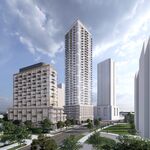LRT stops are selected based on a balance between good local access and high route speed. The greater the distance between stops, the higher the speed of travel. There were two general scenarios considered for stop separation for the Etobicoke-Finch West Transit City Corridor:
1) LRT stops every 800 metres like a ‘surface subway’, stopping only at major intersections, with infrequent parallel bus service (e.g. every 20 minutes) servicing bus stops in between. At LRT stops, customers transfer to centre LRT platform from side of road bus stop.
2) LRT stops every 400 metres – stopping at every major intersection, and once in between, with no infrequent parallel local bus service.
TTC developed a micro-simulation to examine the impacts of stop spacing of the Sheppard East LRT. A stop spacing of 800 metres resulted in a route speed of 26-27 km/h, while a stop spacing of 400 metres had a route speed of 22-23 km/h. The wider spacing did not result in as much of a speed advantage as expected; while the LRT stopped less often, the time for customers to board took twice as long per stop (same number of passengers collected at half the stops) and the LRT still had delays due to red lights at signalized intersections in between stops (although the model accounted for possible signal priority to reduce such delays). The wider spacing scenario was not selected because the full impact of the increased speed of the LRT applies only to those walking directly to LRT stops. Those boarding local buses at bus stops in between LRT stops have a shorter walk, but a longer waiting time for service and a transfer to the LRT after a very short bus ride.
In recognition of these results, the recommendation for stop spacing for the Etobicoke-Finch West line is in the order of 400 to 600 metres, depending upon the pattern of development and the location of cross-streets, with an expected average speed of 22 to 23 km/h; this is considered to be the best balance between the overall route speed and good local access. The stop spacing may be greater at some locations for the Etobicoke-Finch West LRT due to terrain and undeveloped zones along the corridor, as well as the interchange and related roadways at Highway 400. For purposes of comparison, during peak operating conditions, the average speed of the Bloor-Danforth subway line is 30 km/h, the 36 Finch West bus service is 17 km/h, and the 510 Spadina streetcar service is 14 km/h.




